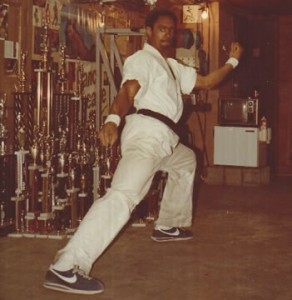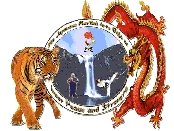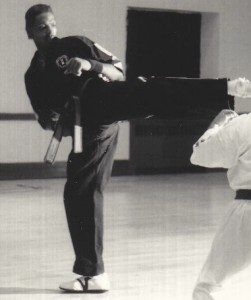“The History of the Martial Arts School of Inner Peace and Strength”

Kyoshi Giles
The Martial Arts Dojo of Inner Peace and Strength was founded in 1969 by Kyoshi Randy Giles and James McCoy bringing the martial arts of Japanese Shotokan, Japanese Goju Ryu and Korean Tae kwon do together as one, but it did not end there. Having an interest in various forms of martial arts, both Giles and McCoy endeavored to enhance their arts taking various techniques from different styles and adding them to their school’s system. Using Japanese Shotokan katas and fighting techniques as a foundation Giles and McCoy utilized and combined the best from each of the various martial art forms to make their system of Shotokan not only strong and swift, but fluent, explosive, agile and unpredictable.
The system that Giles and McCoy developed incorporated the powerful swift low stances and techniques of Shotokan, which is geared toward close quartered combat with short and precise techniques. Taking what they had learned from Japanese Goju Ryu, which means hard and soft Giles and McCoy enhanced the internal power of the Shotokan, making it more explosive as well as fluent like water. Along with the high kicks of Korean Tae kwon do it made Giles and McCoy’s new system of Shotokan even more flexible and their art was becoming more rounded. The funny thing is it wasn’t until some years later that Giles discovered that Gichin Funakoshi the Founder of Japanese Shotokan wanted to do the same thing with his art.
In 1918 Funakoshi wanted to have a center where all martial artist could come and train and share their art with one another. In this martial arts center there would be no master, no sensei, everyone would be equal with no one in charge. Funakoshi believed that every martial art style is meant to change that each martial artist was his or her own style. Gichin Funakoshi said that the “DO” at the end of “Karate-DO” implies that it has a life of it’s own and is meant to change from Karateka to Karateka, which means from one martial artist to another the style of martial art is meant to change. Kyoshi Giles and McCoy didn’t realize it, but they were on the same track as the Japanese Shotokan Founder over 51 years before Giles and McCoy founded their Martial Arts Dojo of Inner Peace and Strength.
 The martial arts of the late 1960 were still very clannish especially in the countries of Japan, Korean and China. In order to control the uncontrollable these countries formed organizations, such as the JKA (the Japanese Karate Association), the KTA (the Korean Taekwondo Association) etc, etc. These associations were developed to have control over the style(s) of martial arts, which then flowed over into the United States and other countries. Their strict governing rule other martial masters endeavored to enhance their arts and the hybrid martial arts styles emerged. Looking at history way before, Japan, Korean and China tried to control the martial arts in their countries, various martial artists began improvising and enhancing their art forms. This is how so many martial art styles came to be, changed throughout time due to necessity and practicality and most of these hybrid styles were put to the test as they were in the olden days, in Kumite (free style combat).Over the years, Kyoshi Giles who eventually headed the Martial Arts Dojo of Inner Peace and Strength as Kyoshi James McCoy life interests led him elsewhere. The school’s emblem was designed by Sensei Giles with the help of Kyoshi McCoy, which was the Korean Flag over the Shotokan Tiger with the Japanese Goju Fist in the pit of the Shotokan Tiger’s stomach in 1969.
The martial arts of the late 1960 were still very clannish especially in the countries of Japan, Korean and China. In order to control the uncontrollable these countries formed organizations, such as the JKA (the Japanese Karate Association), the KTA (the Korean Taekwondo Association) etc, etc. These associations were developed to have control over the style(s) of martial arts, which then flowed over into the United States and other countries. Their strict governing rule other martial masters endeavored to enhance their arts and the hybrid martial arts styles emerged. Looking at history way before, Japan, Korean and China tried to control the martial arts in their countries, various martial artists began improvising and enhancing their art forms. This is how so many martial art styles came to be, changed throughout time due to necessity and practicality and most of these hybrid styles were put to the test as they were in the olden days, in Kumite (free style combat).Over the years, Kyoshi Giles who eventually headed the Martial Arts Dojo of Inner Peace and Strength as Kyoshi James McCoy life interests led him elsewhere. The school’s emblem was designed by Sensei Giles with the help of Kyoshi McCoy, which was the Korean Flag over the Shotokan Tiger with the Japanese Goju Fist in the pit of the Shotokan Tiger’s stomach in 1969.

Tee Taylor
Ten years later while training with Sensei William “Billy” T. Taylor, Taylor was trying to come up with his own school emblem for a hybrid system he had created called “Sho Yun O”. Sho = Shotokan, Yun, Yunokwan and O for Okinawate. Kyoshi Giles designed an emblem showing the Red Japanese sun and crescent moon with the North Star a house made of oriental characters with a monk in the lotus position sitting in the house as the house floats above a water fall which flows into two martial artists. One martial artist in a black martial uniform who’s standing in Sanchin dachi (Hour glass position) with one fist open and the other closed. The water fall also flows through another martial artist who’s wearing a white martial arts uniform who’s thrown out a side kick with the left leg along with a left back fist while his right hand which is open guards his center line. The colors of the emblem covered the range of the belts in the martial arts white, yellow, orange, blue, green, purple, red, brown, black with a gold frame. The emblem’s colors covered all the colors in the Japanese, Korean and Chinese arts as Sensei Giles, did want the emblem to be well rounded and worldly as he felt a martial artist should always strive to be. In any case, Sensei William “Billy” T. Taylor did not accept Kyoshi Giles’ design, and so Kyoshi Giles decided to use it for his dojo, for the Martial Arts School of Inner Peace and Strength. With the help of one of Kyoshi Giles top students, Sensei Jorge Abreu, the new School emblem came to fruition.
